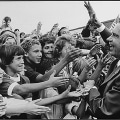As an expert in political science and elections, I have closely studied the impact of candidate campaigns on voter turnout in Southeast Texas. This region is no stranger to competitive and highly contested races, and as election season approaches, the focus shifts to the candidates and their campaigns.
The Importance of Voter Turnout
Voter turnout is a crucial aspect of any election. It measures the percentage of eligible voters who actually cast their ballots. A high voter turnout indicates a strong and engaged electorate, while a low turnout can suggest apathy or disinterest in the political process. In Southeast Texas, voter turnout has been a topic of concern in recent years.In the 2016 presidential election, only 55% of registered voters in the region turned out to vote. This was lower than the statewide average of 59%. In the 2018 midterm elections, Southeast Texas saw a slightly higher turnout of 57%, but still fell below the statewide average of 59%.
The Impact of Candidate Campaigns
So how do candidate campaigns affect voter turnout in Southeast Texas? The answer is not a simple one. There are many factors that can influence voter turnout, including demographics, political climate, and campaign strategies. One major factor that can impact voter turnout is the competitiveness of a race.When there is a highly contested race, voters are more likely to feel motivated to participate in the election process. This can be seen in the 2018 midterm elections in Southeast Texas, where there were several closely watched races for congressional seats. Campaign strategies also play a significant role in voter turnout. Candidates who run aggressive and well-funded campaigns are more likely to mobilize their supporters and get them to the polls. This was evident in the 2016 presidential election, where both major party candidates had strong campaign operations in Southeast Texas.
The Role of Demographics
Demographics also play a crucial role in voter turnout.In Southeast Texas, the population is predominantly white and older, which can have an impact on voter turnout. Older voters tend to have higher turnout rates compared to younger voters, and white voters historically have higher turnout rates than minority voters. However, there has been a shift in demographics in Southeast Texas in recent years. The region has seen an increase in its Hispanic population, which could potentially impact voter turnout. In the 2018 midterm elections, there was a noticeable increase in Hispanic voter turnout in some counties in Southeast Texas.
The Influence of Political Climate
The political climate can also have a significant impact on voter turnout.In highly polarized and divisive elections, voters may feel more motivated to participate and make their voices heard. This was evident in the 2016 presidential election, where the contentious race between Donald Trump and Hillary Clinton drove high voter turnout across the country. In Southeast Texas, the political climate has been particularly charged in recent years. The region has been heavily affected by natural disasters, such as Hurricane Harvey in 2017, which can also influence voter turnout. In times of crisis, voters may feel a sense of urgency to vote for candidates who they believe will best address their concerns.
The Future of Voter Turnout in Southeast Texas
As we look towards future elections in Southeast Texas, it is essential to consider the factors that can impact voter turnout.While candidate campaigns play a significant role, there are many other factors at play that can influence the level of participation in elections. Efforts are being made to increase voter turnout in Southeast Texas. Organizations such as the League of Women Voters and the NAACP are working to educate and mobilize voters in the region. Additionally, there have been calls for election reforms, such as early voting and mail-in ballots, to make it easier for voters to participate in the electoral process.





